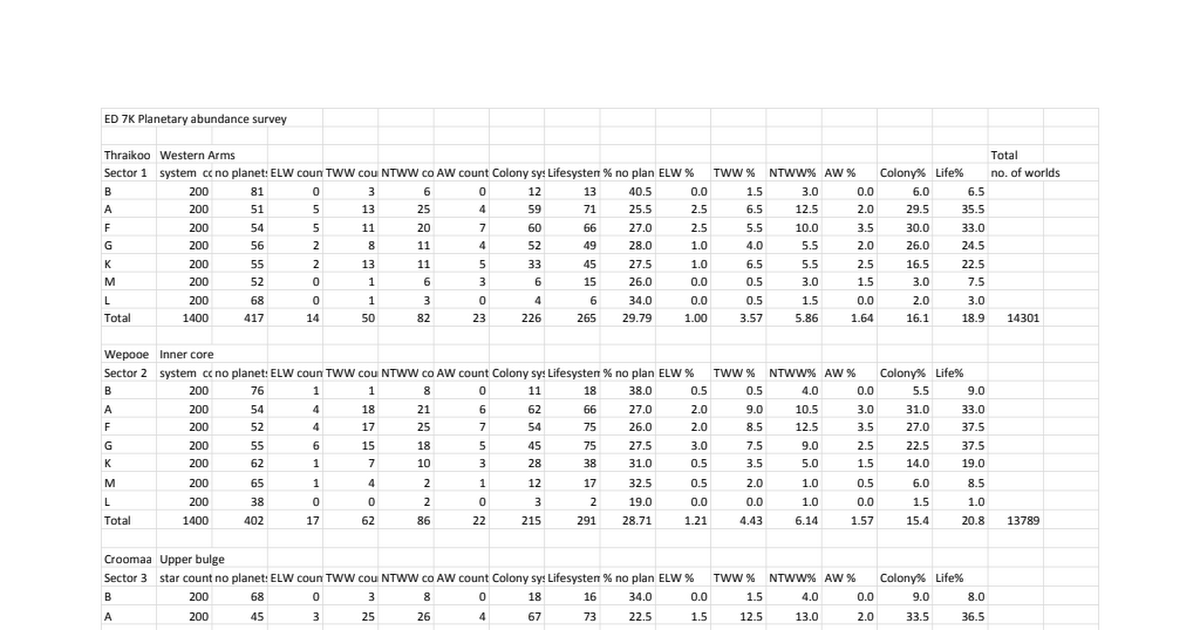After much ummming and aaah-ing, I have finally decided to embark on my next great exploration venture, and dabble in systematic surveying to try and answer some "big questions" which I don't think any other data accumulation has been able to answer conclusively. I originally posted some speculation about this in this thread from August last year. The FSS has been introduced since the original idea, so I have expanded it and altered it to better encompass what the FSS now allows to do.
My goal remains much the same: to visit 1400 stars - 200 of each of the most common star types (B, A, F, G, K, M and L) - in five different sectors, for a total of 7000 stars. It's a big ask, especially since my grand total of visited stars before I set off, in the four years I've been playing this game, was only about 16,000 stars. My aim is to subsample the stars in each sector more or less randomly across the entire sector, to try to eliminate any biases that individual boxels of stars might generate.
I've chosen to use star class, rather than mass codes or boxels, as the primary sorting characteristic, because star classes can be easily filtered for on the galaxy map - mass codes and boxels currently cannot. My asumption is that many explorers either do not filter stars at all (using Realistic mode to navigate) or filter certain star classes in or out, for optimal hunting of their targets (usually ELWs or other valuables). For star classes that occur across several mass codes, I am attempting to get a "random sample" within each sector. I will neither deliberately aim for, nor deliberately exclude, stars with "abnormal" mass codes - I'll take whatever the route plotter gives me.
The aim is to try to answer questions like the following:
- Just how much more common are water worlds, compared to ammonia worlds and ELWs? My "gut feeling", statistics-free answer to this question is that it's about a 10:3:1 ratio, but other explorers are reporting something more like 10:1:1. I will be investigating this, and whether there is a noticeable difference in the ratio across the different star types (eg. are ammonia worlds relatively much more common in K-class systems?)
- Just how common are life-bearing planets - any kind of life - in the galaxy? By "life-bearing planet" I don't mean planets with biological signals, I mean one of the following planet types: ELW, WW, AW, GGWBL and GGABL. Again, my "gut feeling" is that about one in five star systems has at least one life-bearing planet of some kind in it . This survey won't directly answer the question, since it doesn't address the relative abundance of the various star types, but it should at least help point us in the right direction. Perhaps the vast majority of life-bearing planets are "hiding" in star types that explorers traditionally ignore (such as M-class).
- What advice should we be giving to newbie explorers, as to which stars to filter for (a) best chance at Earth-likes, and (b) maximum credits? "FIlter for F and G", "Filter for F only", "Filter for F, G and A" are all advice I've seen posted. There seems to be consensus that F-class is better. Is this true, and if so, by how much?
- Other minor questions will be asked and, hopefully, answered, as the survey progresses and the data examined. For example: what are the relative abundances of the "normal" class 1 to class 5 gas giants? Anecdotally, Class 3 are the most common... but how much more common, and how is it affected by star class? It seems logical that "hotter" classes would be more common around hotter stars, so will the "class 3 is most common" hold true across star types?
The advent of the FSS has allowed the original scope of the Project to be expanded. Rather than just looking at the "big three" (ELW, WW and AW), I'm going to do a comprehensive survey of each planet type. My methodology shall be as follows:
I have selected the five sectors I will be targeting; they are located in the following regions: Perseus Arm (Vulcan Gate); Outer Core (Odin's Hold / Empyrean Straits border region); Inner Core (Galactic Centre); Inner Norma Arm (Norma Arm); Carina Arm (Hawking's Gap region). As I am also attempting to survey the extent of commander exploration in these sectors, please forgive me for withholding the exact names of the sectors until each sector is complete. I will try to pull into port and sell the data as soon as possible after each survey is completed, to optimize discussion of the data.
I departed Human Space on the 24th of April aboard my favoured exploration vessel, the Erebus. Just over 50 LY max jump range. Arrived in the Vulcan Gate Sector on 2nd May and began the survey, beginning with the combined Class B / Class L series. I've finished these surveys today and am now a quarter of the way through the A-class survey.
Will post some preliminary results for the Class B and Class L systems in my next post.
Edit on 14/10/20: for those coming late to the party, the survey is now complete and the survey statistics can be found on this Google Docs spreadsheet:

 docs.google.com
docs.google.com
My goal remains much the same: to visit 1400 stars - 200 of each of the most common star types (B, A, F, G, K, M and L) - in five different sectors, for a total of 7000 stars. It's a big ask, especially since my grand total of visited stars before I set off, in the four years I've been playing this game, was only about 16,000 stars. My aim is to subsample the stars in each sector more or less randomly across the entire sector, to try to eliminate any biases that individual boxels of stars might generate.
I've chosen to use star class, rather than mass codes or boxels, as the primary sorting characteristic, because star classes can be easily filtered for on the galaxy map - mass codes and boxels currently cannot. My asumption is that many explorers either do not filter stars at all (using Realistic mode to navigate) or filter certain star classes in or out, for optimal hunting of their targets (usually ELWs or other valuables). For star classes that occur across several mass codes, I am attempting to get a "random sample" within each sector. I will neither deliberately aim for, nor deliberately exclude, stars with "abnormal" mass codes - I'll take whatever the route plotter gives me.
The aim is to try to answer questions like the following:
- Just how much more common are water worlds, compared to ammonia worlds and ELWs? My "gut feeling", statistics-free answer to this question is that it's about a 10:3:1 ratio, but other explorers are reporting something more like 10:1:1. I will be investigating this, and whether there is a noticeable difference in the ratio across the different star types (eg. are ammonia worlds relatively much more common in K-class systems?)
- Just how common are life-bearing planets - any kind of life - in the galaxy? By "life-bearing planet" I don't mean planets with biological signals, I mean one of the following planet types: ELW, WW, AW, GGWBL and GGABL. Again, my "gut feeling" is that about one in five star systems has at least one life-bearing planet of some kind in it . This survey won't directly answer the question, since it doesn't address the relative abundance of the various star types, but it should at least help point us in the right direction. Perhaps the vast majority of life-bearing planets are "hiding" in star types that explorers traditionally ignore (such as M-class).
- What advice should we be giving to newbie explorers, as to which stars to filter for (a) best chance at Earth-likes, and (b) maximum credits? "FIlter for F and G", "Filter for F only", "Filter for F, G and A" are all advice I've seen posted. There seems to be consensus that F-class is better. Is this true, and if so, by how much?
- Other minor questions will be asked and, hopefully, answered, as the survey progresses and the data examined. For example: what are the relative abundances of the "normal" class 1 to class 5 gas giants? Anecdotally, Class 3 are the most common... but how much more common, and how is it affected by star class? It seems logical that "hotter" classes would be more common around hotter stars, so will the "class 3 is most common" hold true across star types?
The advent of the FSS has allowed the original scope of the Project to be expanded. Rather than just looking at the "big three" (ELW, WW and AW), I'm going to do a comprehensive survey of each planet type. My methodology shall be as follows:
- Travel to target sector.
- On arrival, set star class filter to a single target star class. Class B and Class L shall be analysed simultaneously, as Class L needs to be combined with something fuel-scoopable.
- On arrival in each system, honk the Discovery Scanner and record the number of objects detected via the honk.
- Use the FSS to scan every single object in the system.
- Spreadsheet the count of planet types, according to the 21 planet categories likely to be encountered in procedurally-generated systems. I will not be distinguishing landable/non-landable, as I still have hope that every planet type will one day become landable.
- Plot transects across each sector, using either Economic or Fastest route modes (whichever seems most appropriate for the star class).
- Survey 200 systems of the selected class, then switch the map filter to the next class.
- Repeat until all seven star classes are surveyed.
- Move to next selected sector.
I have selected the five sectors I will be targeting; they are located in the following regions: Perseus Arm (Vulcan Gate); Outer Core (Odin's Hold / Empyrean Straits border region); Inner Core (Galactic Centre); Inner Norma Arm (Norma Arm); Carina Arm (Hawking's Gap region). As I am also attempting to survey the extent of commander exploration in these sectors, please forgive me for withholding the exact names of the sectors until each sector is complete. I will try to pull into port and sell the data as soon as possible after each survey is completed, to optimize discussion of the data.
I departed Human Space on the 24th of April aboard my favoured exploration vessel, the Erebus. Just over 50 LY max jump range. Arrived in the Vulcan Gate Sector on 2nd May and began the survey, beginning with the combined Class B / Class L series. I've finished these surveys today and am now a quarter of the way through the A-class survey.
Will post some preliminary results for the Class B and Class L systems in my next post.
Edit on 14/10/20: for those coming late to the party, the survey is now complete and the survey statistics can be found on this Google Docs spreadsheet:
ED 7K Planetary Survey
Summary ED 7K Planetary abundance survey Thraikoo,Western Arms,Total Sector 1,system count,no planets,ELW count,TWW count,NTWW count,AW count,Colony systems,Lifesystems,% no planets,ELW %,TWW %,NTWW%,AW %,Colony%,Life%,no. of worlds B,200,81,0,3,6,0,12,13,40.5,0.0,1.5,3.0,0.0,6.0,6.5 A,200,51,5,13
Last edited:

















